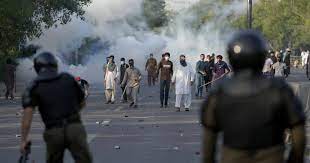ISLAMABAD:The PTI’s approach to disassociate itself from the events of last year’s May 9 violence just ahead of its first anniversary seems to be resorting to the oldest trick in the book — do not admit that you are wrong and keep blaming others. However, it does not seem to be working.
At a time when PTI’s founding chairman Imran Khan is openly blaming the security establishment for the last year’s May 9 mayhem and explicitly telling a British newspaper, the Telegraph, that the incumbent army chief Gen Asim Munir will be responsible if anything happens to him or his wife, the experts say that there is little chance of the party receiving a clean chit in connection with the ‘Black Day’ events.
Surprisingly, all this took place on the heels of PTI’s former National Assembly speaker Asad Qaiser’s speech in the lower house of parliament, where he claimed that incumbent Interior Minister Mohsin Naqvi and the Punjab police chief orchestrated the May 9 attacks.
While hurling these accusations for the past few weeks, the PTI leadership has also demanded the formation of a judicial commission to investigate into the May 9 riots, leaving many wondering if that is the right approach to reverse the irreparable damage the party inflicted upon itself on that fateful day last year.
On May 9, 2023, the installations of the security establishment were attacked allegedly by enraged PTI activists and supporters after the law enforcement authorities arrested their party’s founding chairman from the premises of the Islamabad High Court on the charges of corruption.
Back then, the PTI declared that arresting Imran would be tantamount to crossing its red line. Following the attacks on its installations including its martyrs’ memorials, the military declared May 9 as a “Black Day”, describing it as a “dark chapter” of the country’s history.
Political analyst Majid Nizami noted that the PTI was desperately trying to reverse or, at least defuse, the May 9 mayhem by giving controversial statements and blaming others, knowing well that its party leaders and activists were present at the places where the attacks took place or were found to be instigating people to resort to violence there.


